Swedish military taxi
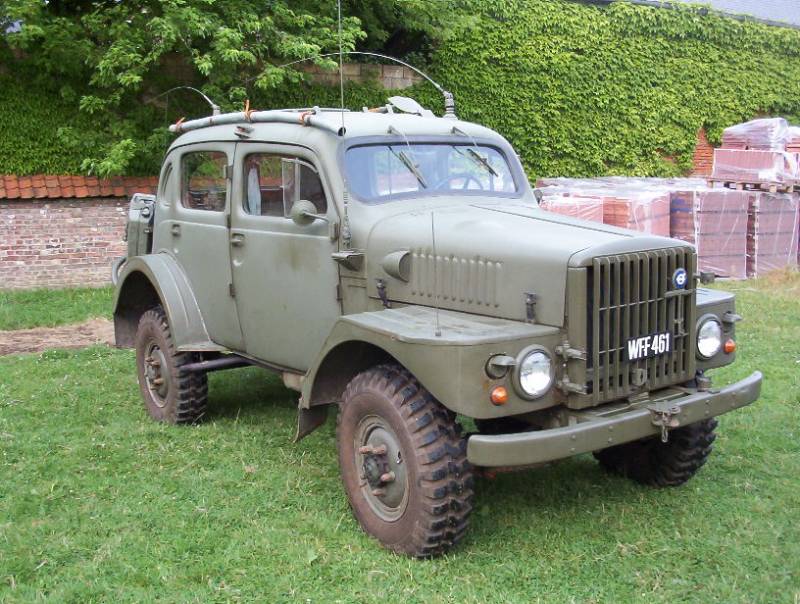
“In the difficult and difficult conditions of the war with Russia, we were no longer talking about technically flawless and impressive design of vehicles; simplicity and a large margin of safety were important here. The too late realization of this led to the creation of semi-trucks, originally conceived as cargo trucks, which were subsequently produced with more spacious and at the same time simpler bodies of eight-seater passenger cars...” Engineer Werner Oswald.
prehistory
This not very sonorous word “Volvo” is well known to every Russian person. An older motorist will probably remember the good old 80s, born in the 240s, which amazed Soviet people unaccustomed to foreign cars with their durability and phenomenal reliability. A younger motorist will remember the huge angular suitcase station wagons of the 1990 and 740 series produced since 760 - a summer resident’s dream.
All these worthy, solid cars, natives of snowy Sweden, remained in people's memory as strong, reliable cars with decent ground clearance, not afraid of the harsh Russian winters and giving their owners comfort and warmth in the cabin, as well as “iron” stability when driving on the roads.
But then the 2002st century burst into our lives and brought with it a galaxy of new all-wheel drive cars from Volvo, which did not exist in the 90th century. The company began to actively invade the new crossover market, and in XNUMX, the Volvo XCXNUMX was presented at the Detroit auto show, after which articles began to appear in the press announcing that Volvo had presented the world with its first passenger “SUV.” But is it the first?
Who said that in the twentieth century, Volvo did not produce passenger cars with power drive to all wheels, adapted for off-road use? Comrades, we don’t know well history this small company, which is famous for its cars all over the world.
A little history of the Swedish car company Volvo
The world first heard this word on April 14, 1927, when the first passenger car under the Volvo brand, derived from the Latin word volvere - to roll, rotate, rolled out of the gates of the plant in the Swedish city of Gothenburg. The company was founded by two Swedes: economist Assar Gabrielsson and engineer Gustaf Larson; they did not set themselves the task of necessarily catching up and overtaking anyone, and their main goal was the production of structurally simple and reliable cars. And already in February 1928, the young company mastered the production of trucks, which later brought it worldwide fame.
The first Volvo cars had rear-wheel drive, which is understandable; on the eve of World War II, Sweden remained neutral, and the cars produced were for civilian use. But since 1941, by order of the Swedish military department, the company established small-scale production of military off-road 4x4 military trucks with a carrying capacity of about three tons. In total, from 1941 to 1949, about 1 of these machines were manufactured.
In the late 30s and early 40s of the last century, passenger all-wheel drive patrol and reconnaissance vehicles began to appear in many armies around the world: Stoewer R-200 Special, Hanomag Tip 20B and BMW Tip 325 in Germany; "Bantam-Willis" in the USA; GAZ-64 in the USSR and many others, which established a new type of army vehicle, which later received the common name “jeep”.
There were no such vehicles in the Swedish army. And the Swedes decided to develop a light multifunctional all-wheel drive vehicle for their own army on their own.
Swedish engineers took their time and during the design process carefully studied the experience of the Germans, Americans and Russians, who had gained a lot of knowledge when designing cars of this type.
On the shortcomings of the first army vehicles of World War II
Proud Germans, eager to show the world the superiority of their engineering school, were carried away by complex design solutions, as a result of which their reconnaissance vehicles received permanent all-wheel drive, independent wheel suspension and steering with all steerable wheels, which overcomplicated the design. As you know, with an increase in the number of parts, the probability of breakdown increases, and the outbreak of war with the USSR revealed the extremely low reliability of these machines.
A comical situation arose: some vehicles intended for use in the army could not travel 1 km in conditions of front-line roads and off-road conditions without serious breakdowns. And the complexity of the components and assemblies used necessitated frequent maintenance. In some models, the number of lubrication points reached almost a hundred, which was clearly too much even for that time.
All this splendor was too expensive, requiring numerous mobile auto repair shops, a staff of experienced mechanics and a large number of spare parts.
As a result, in the conditions of the war with Russia, this concept revealed its complete failure.
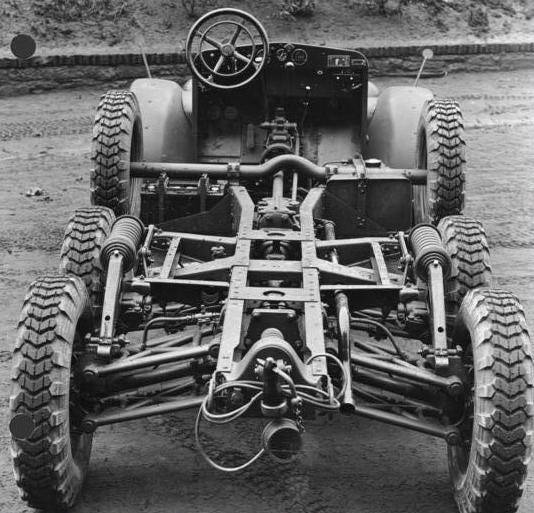
One of the examples of the creation of proud German auto engineers
American designers made another mistake - they made the wheel track of the drive axles of their jeeps too narrow, which is why the Bantams and Willies tried to lie on their side at the first suitable opportunity while driving on slopes and when turning small radii.
Domestic designer V. A. Grachev, when designing the first Soviet jeep GAZ-64, stepped on the same rake as the Americans. Despite the fact that he had axles from the GAZ-61 with a gauge of 1 mm at hand, Grachev, according to the good tradition of that time, when developing new models of Soviet cars, decided to borrow technical solutions used overseas - he shortened the bridge stockings.
The result was two axles with different track sizes: 1 mm at the front and 278 mm at the rear. And the GAZ-1 had stability even worse than that of American jeeps, apparently the reason for this was that the car’s center of gravity was too high. And the first months of military operation revealed another serious drawback of the “narrow gauge” - while driving along rutted dirt roads, a GAZ-245 truck walking in a convoy did not fall into the track they had laid.
As a result, the wheels of one side slid into the rut, and the wheels of the other “cut the ridge” - they pushed apart the liquid soil squeezed out by the tires of the trucks in front into the center of the rut. Because of this, the Russian reconnaissance officer often got stuck, clinging to the crests of the track with the bridge housings. However, American jeeps also had the same drawback.
The Swedes go their own way
The young, but wise beyond his years, Volvo engineer Nils Magnus Hartelius, who was developing the car, understood that when designing a military passenger car, it was necessary to ensure maximum reliability, simplicity of design and wide unification with components and assemblies of mass-produced vehicles.
Therefore, without further ado, he took as a basis a durable chassis from a conventional rear-wheel drive 1,5-ton LV-101 truck, shortened the wheelbase to 3 mm, installed a drive axle in front, and placed an 100-seater body from a handy one on top of the frame. taxi series PV-8.
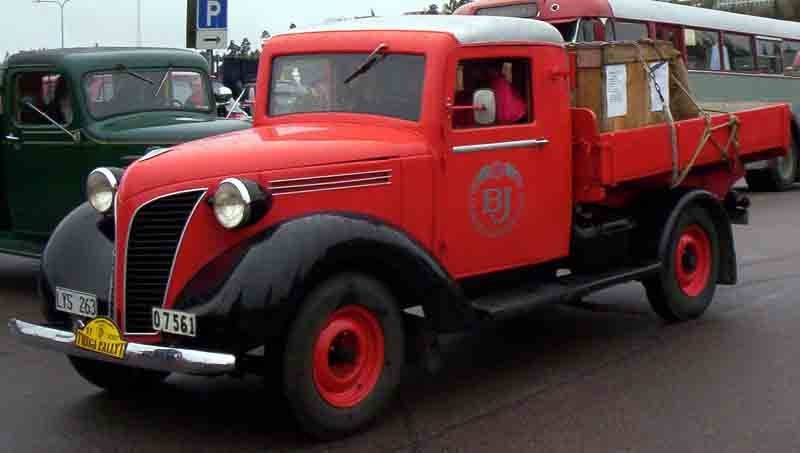
The basis of the car was a Volvo LV-101 truck with a carrying capacity of 1,5 tons
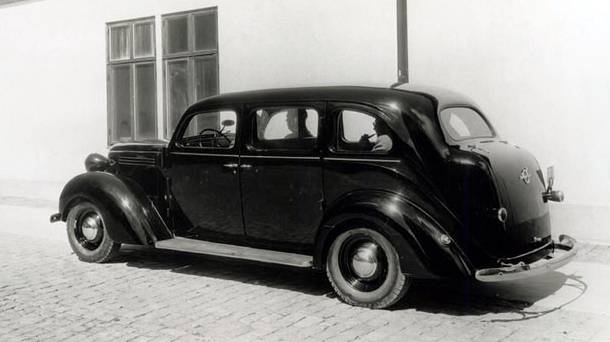
Volvo taxi PV-800 series, whose body was used by the designer
But here a small discrepancy arose: the progenitor truck and taxi had some completely frivolous civilian nose-hoods, which also reached right up to the bumper. Cars with such an appearance are not accepted into the Swedish army, and the graceful hood protruding forward could be damaged in no time when driving in the local small forests.
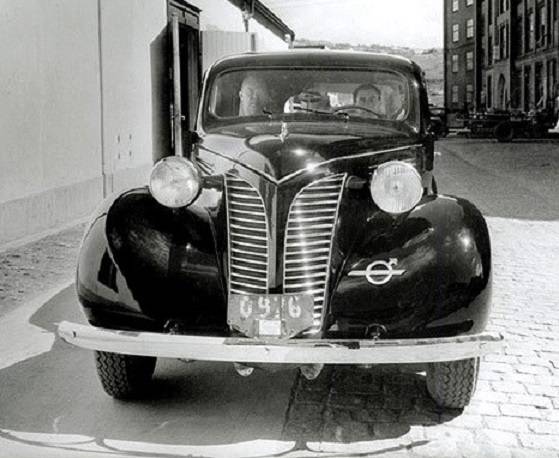
The designers eliminated the problem in the most decisive way; they cut off the taxi body in front of the windshield and welded to it an angular front end, like a TVB truck, ending with a flat and wide lining, behind which an enlarged radiator was comfortably placed.
This technical solution made it possible to improve the efficiency of the cooling system, which was by no means unnecessary for a machine operating at low speeds with a large force of movement resistance. And to protect the radiator from damage, they installed a strong power bumper with additional arches welded in the center, reminiscent of the back of an iron bed.
The headlights of the car were also protected by metal arc strips, as a result, the Swedish “SUV”, which received the abbreviation Terrängpersonvagn m/43 (TPV), could pave the way through small forests without fear of damage from bushes and small trees.
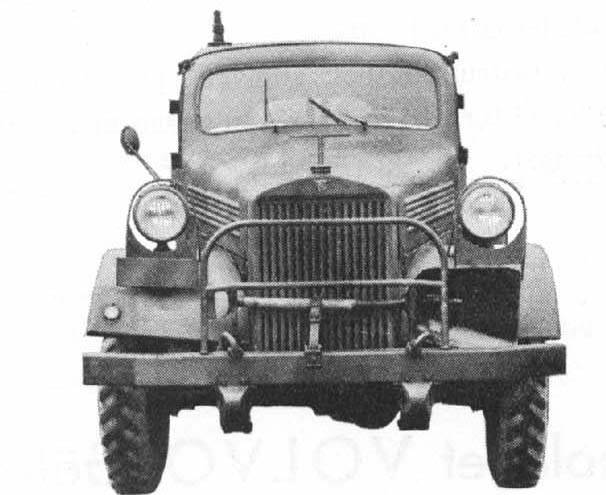
When designing, the Swedes took into account the harsh climate of their country and left the body closed, but the upper part of the roof was made not of metal, but of easily removable canvas.
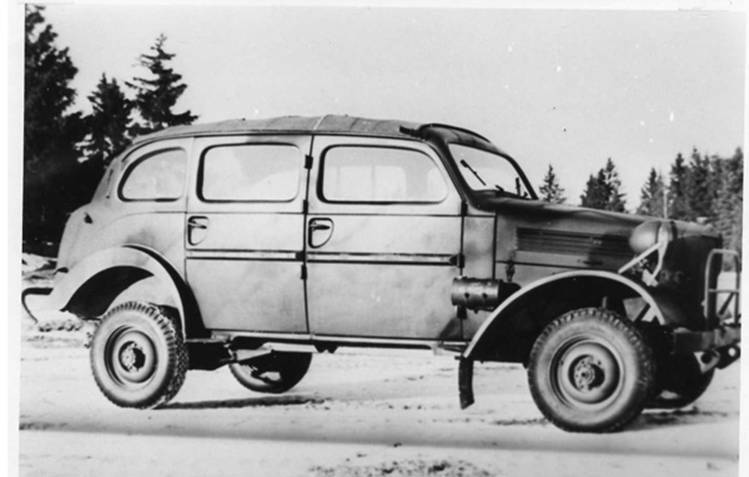
The spacious trunk provided enough space for two spare wheels, mounted vertically at the rear fender wells, and crew duffel bags.
As a result, Swedish engineers came up with an ideal passenger “SUV”: reliable, unpretentious, roomy, with a comfortable interior, and most importantly, it had the same track size as other army vehicles.
The design of the car may not seem entirely aesthetic to some, due to the obvious mismatch between the shapes of the front part and the body, but in war aesthetics fade into the background, the main thing here is functionality, and with this the Swedish car was all right.
But it’s wrong to call this car the first Swedish jeep, that is, a light patrol and reconnaissance vehicle. The Swedes did not skimp on metal; as a result, the weight of the equipped vehicle was twice that of the American Willys, and amounted to 2 kg, and in terms of dimensions, the Swedish “SUV” was much larger, its dimensions (length/width/height , mm) were 340 x 4 x 800. The total weight of the vehicle was 1 kg, engine power 800 hp. With.
With the transmission, the Swedes also did not try to be too clever and organized a locked (without center differential) drive, which provides for the possibility of forcibly disabling the front axle while driving on surfaces with good wheel grip. Power was distributed between the axles through a single-stage transfer case, and to improve cross-country ability, the rear axle differential could be forcibly locked. The locking drive was mechanical using a rigid piano wire type moving in a braid.
Good cross-country ability was ensured by solid ground clearance and large-diameter wheels with increased lugs. The spring suspension in combination with massive beam axles guaranteed the chassis phenomenal strength.
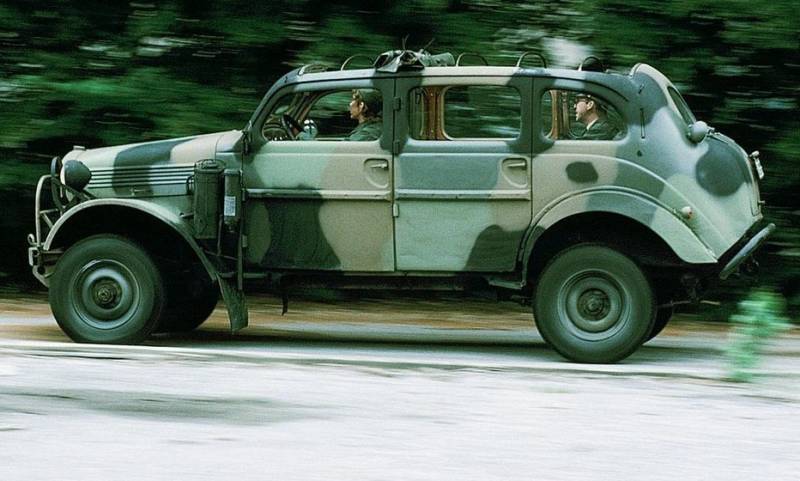
The large car accommodated the crew freely and comfortably
As a result, the first Swedish command 4x4 “outgrew” light reconnaissance vehicles, called jeeps, and entered the next weight category of light army all-wheel drive vehicles of that time, called by the Germans “medium standard passenger car”, typical representatives of which were the German Horh-901 and Vanderer- 901. But in the USSR, cars of this class were never produced at all.
Of the domestic wartime vehicles, in terms of overall dimensions (4 x 670 x 1) and load capacity, the GAZ-770-1, produced from 950–61, came closest to this category. in the amount of 73 copies. But it was built not on a cargo platform, but on a passenger platform, had a mass of 1941 kg and “fit into” the group of light patrol vehicles, although for its functional purpose it was not a patrol and reconnaissance vehicle, but an operational vehicle for the senior command staff of the Red Army and carried only generals .
The first serial Swedish passenger "SUV" Terrängpersonvagn m/43 (TPV) left the factory in 1944, production continued until 1946, a total of 210 copies were assembled. This car is also known under the symbol Volvo-911. The new vehicle served as an operational staff vehicle for mid-level command personnel and was equipped with a powerful radio station.
The second generation
In 1953, the Swedes developed the second generation of this model.
According to one version, the basis of the new vehicle was the shortened chassis of the Volvo-953 (TL11) airfield tractor; according to another, on the contrary, the tractor was made on the basis of an “SUV”. But, in my opinion, both of them were children of the prototype 1948x6 TL6 truck tested since 21, which gave life to both them and the 1954x6 TL6 Lastterrängbil 22 military flatbed truck released in 912, and its modification “935” with a kung . From him the children inherited this characteristic nosed appearance.
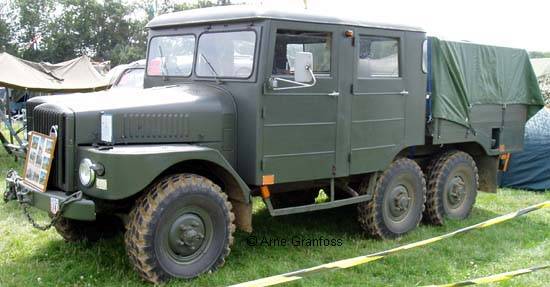
Father of the family truck TL21
I think that the engineers took the chassis from the TL21 truck, shortened it a little and, according to established tradition, “married” it with a passenger body from the PV-830 taxi. And then they attached the hood and fenders from a truck to the passenger body (or the body to the hood, who will understand them, those inventive Swedes). It's just that taxis in Sweden have shrunk a bit over the years, and the interior of the new five-seater is cramped than that of its predecessor.
However, this did not stop us from installing a table in front of the rear seats for placing radio equipment and working with documents and maps. The car received two fuel tanks: the main one with a capacity of 76 liters and an additional one with a capacity of 10 liters. But to ensure a good off-road range, in the rear of the body, on the sides, the engineers provided brackets holding two cans of gasoline, and two patrol bicycles were mounted in the middle.
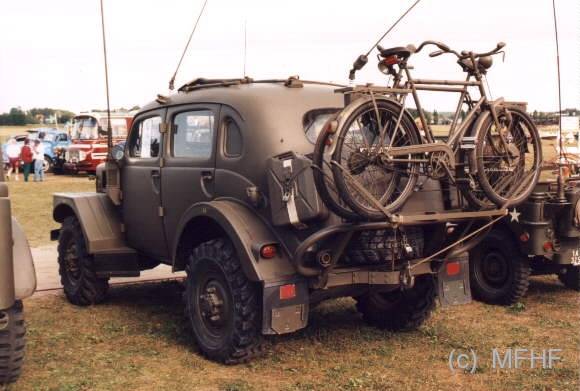
The designers abandoned the canvas roof; now it has become completely metal, but a wide iron hatch was installed in its rear part.
The car was driven by a 6 liter 3,67-cylinder petrol engine producing 90 hp. With. at 3 rpm with a maximum torque of 600 Nm at 220 rpm and a 1-speed gearbox.
The center drive was still without a differential with a “rigid” connection of the front axle, the transfer case received a reduction gear with a number of 1,44, the differentials of both axles were equipped with forced locking. The ground clearance under the axle housings was 250 mm, and time-tested technical solutions were retained in the chassis: beam axles and spring suspension. The wheelbase became smaller - 2 mm, which improved geometric cross-country ability, the front track width was 730 mm, the rear - 1 mm.
The length of the machine decreased by 100 mm and became 4 mm, but the width and height increased and amounted to 700 mm and 1 mm, respectively.
The Swedes again did not spare the hardware, and the curb weight of the car increased to 2 kg, and the total weight to 880 kg. The tires had dimensions 3x440. The maximum speed of the car on the highway in 900th gear reached 16 km/h, which was quite enough for a military “SUV” of those years, and fuel consumption, depending on the design of the tires, was 4–90 liters per 18 km on roads, and reached up to 24–100 liters per 60 km.
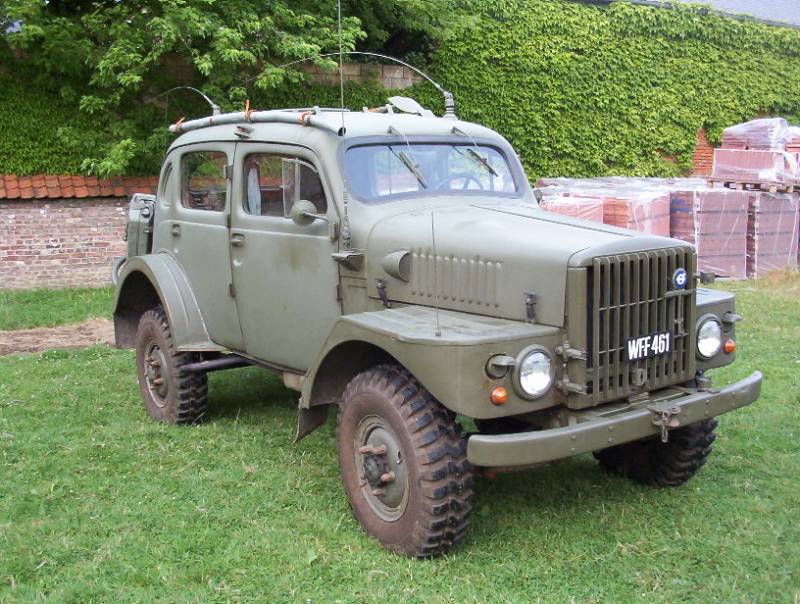
Even from the photograph you can feel that the car has an incredible margin of safety
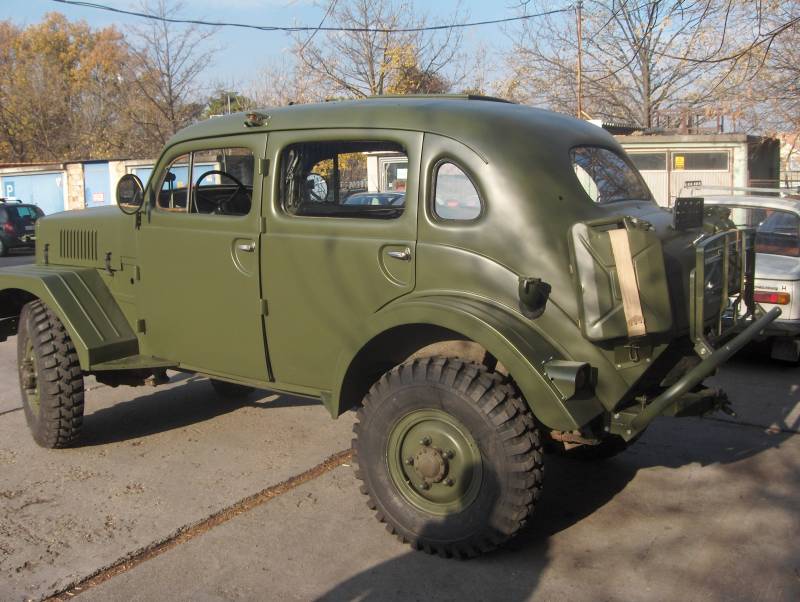
A strong bumper made of a thick pipe protected the rear of the car; the grille for mounting bicycles, if necessary, folded down without interfering with access to the trunk
The new vehicle was given the index TP21/P2104 and the military name Radiopersonterrängbil 915. Its production began in 1953 and ended in 1958. During this time, 720 copies were produced; they served as operational staff vehicles for mid-level command personnel or mobile radio stations.
At the very first maneuvers, a car with a huge blunt snout and a thick rounded loin, slowly crawling up to its ears in the mud, busily grunting with a muffler, was dubbed a pig (Suggan) by one of the military men. As a result, this offensive nickname stuck to her. However, what's offensive about that? In my opinion, the slogan “Pigs are not afraid of dirt” is quite suitable for a real off-road conqueror.
These unusual cars with an angular “truck” front and a smooth passenger body turned out to be very strong, and served in the army for a long time. And after retiring, they worked in civilian life, delighting their employers, causing incredible delight among Swedish children, and periodically frightening with their menacing appearance any small little thing that came their way while driving along the highway.
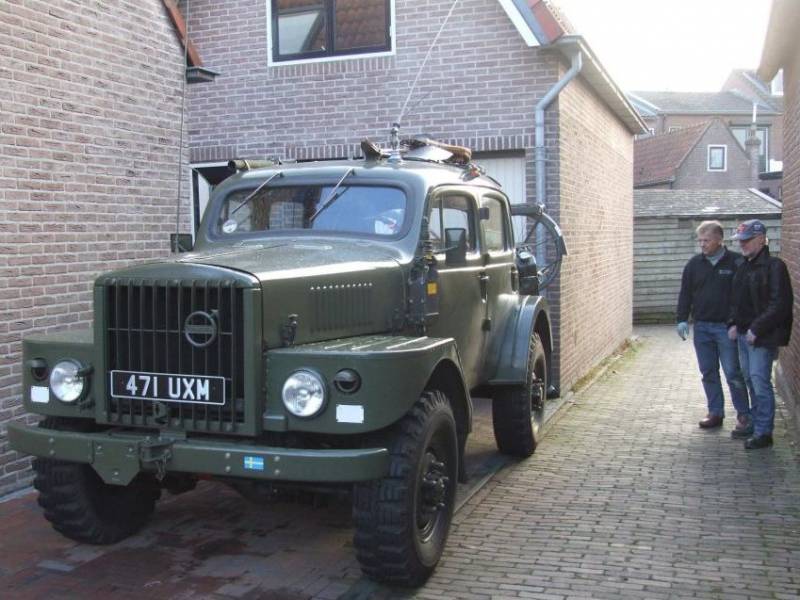
Many machines from the TP21 series have survived to this day and still amaze specialists with their thoughtfulness and functionality.
And this is the “little brother” TP21 military airfield tractor aviation TL12 Startbil 954. It weighed 3 kg and had a payload capacity of 040 kg. In the back of some tractors there was a generator used to start aircraft engines (photo below):
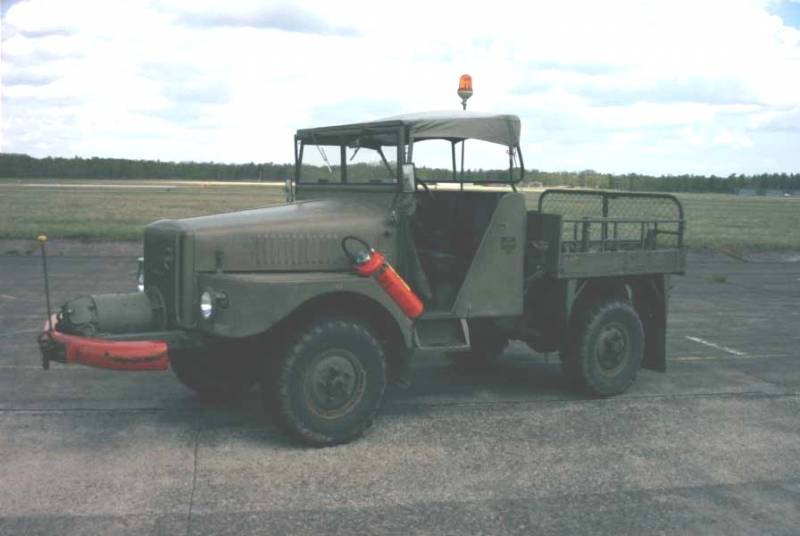
There was also an “older brother” - the TL22 6x6 truck, produced in 1956–1962. in the amount of 920 pcs. (photo below):
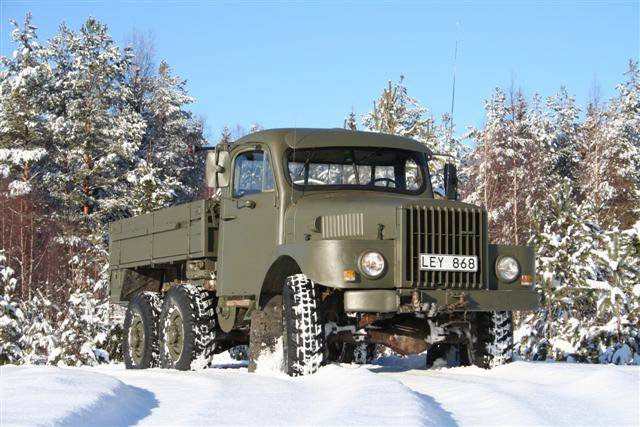
We look at these cars, born in the distant 40s and 50s, and a slight sadness involuntarily fills our hearts: yes, there was once a time of strong people, good things and reliable cars. Alas, it is gone forever, and only the round glass headlights will blink goodbye, the angular front end will sadly nod with an iron bumper, as if saying goodbye forever...
But suddenly the hoarse horn suddenly barks in the same loud commander’s bass: “Give up what you’re doing. Get ready for a hike!”
And again the engine will roar, the gears in the gearbox will click, the evil tires will bite into the soft clay with their lugs, lumps of damp earth and small pebbles will fly from under them in all directions, and the old military vehicle will walk briskly through the copse, scaring away the forest animals: the Swedish command vehicle The army, like 50 years ago, will confidently begin to complete its task.
Information